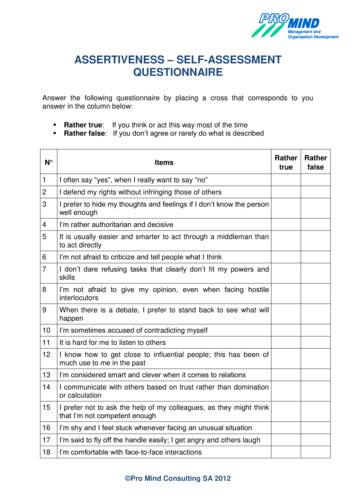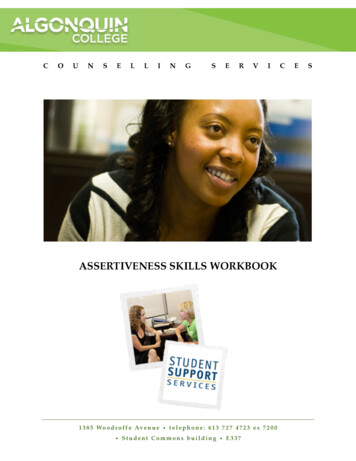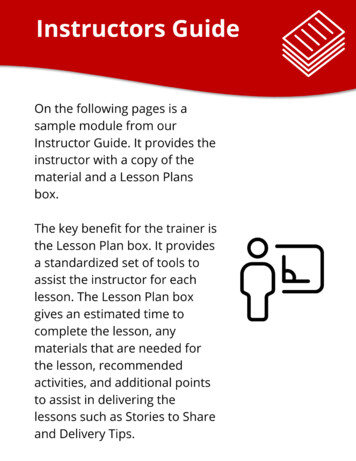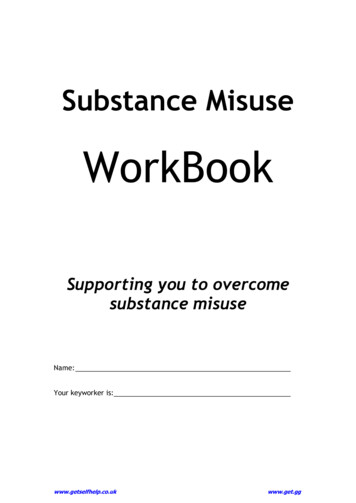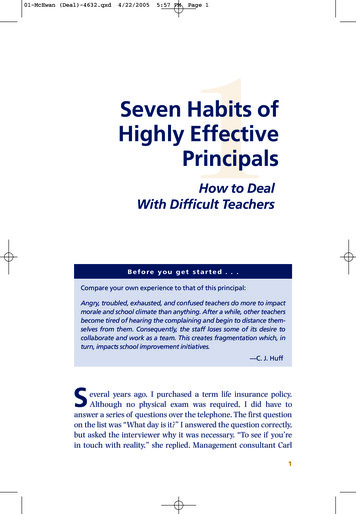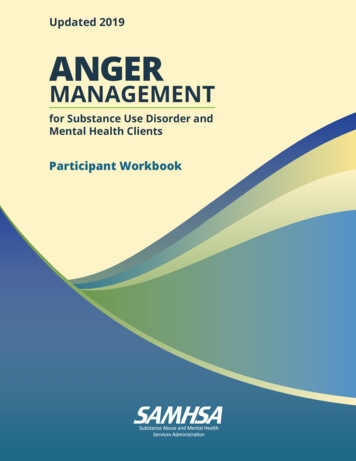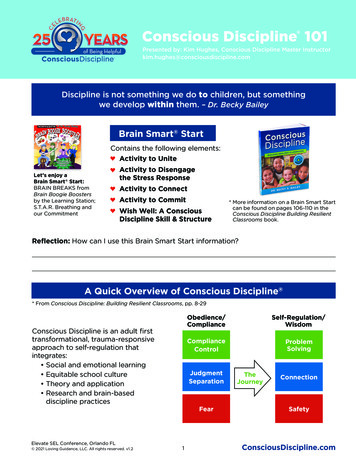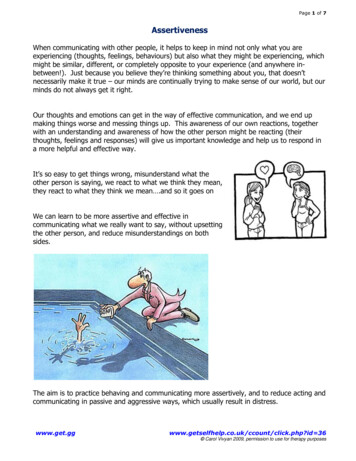
Transcription
Page 1 of 7AssertivenessWhen communicating with other people, it helps to keep in mind not only what you areexperiencing (thoughts, feelings, behaviours) but also what they might be experiencing, whichmight be similar, different, or completely opposite to your experience (and anywhere inbetween!). Just because you believe they’re thinking something about you, that doesn’tnecessarily make it true – our minds are continually trying to make sense of our world, but ourminds do not always get it right.Our thoughts and emotions can get in the way of effective communication, and we end upmaking things worse and messing things up. This awareness of our own reactions, togetherwith an understanding and awareness of how the other person might be reacting (theirthoughts, feelings and responses) will give us important knowledge and help us to respond ina more helpful and effective way.It’s so easy to get things wrong, misunderstand what theother person is saying, we react to what we think they mean,they react to what they think we mean .and so it goes onWe can learn to be more assertive and effective incommunicating what we really want to say, without upsettingthe other person, and reduce misunderstandings on bothsides.The aim is to practice behaving and communicating more assertively, and to reduce acting andcommunicating in passive and aggressive ways, which usually result in ick.php?id 36 Carol Vivyan 2009, permission to use for therapy purposes
Page 2 of 7It can help to think about a person who you respect and who you believe acts andcommunicates effectively and assertively, respecting others and themselves, who is warm andfriendly. This can be a person who is known personally to you, or a famous person, orperhaps a fictional character.You can model yourself on that person – imagine them dealing with particular situations andhow they would do it, what that would look like. Then imagine yourself acting in a similar way– and do it. Practice it often.Initially, it doesn’t matter if you don’t feel like being assertive, just practice it anyway. Whenyou notice yourself acting aggressively or passively, just notice, then change your posture,expression and behaviour to as though you were being assertive. It .php?id 36 Carol Vivyan 2009, permission to use for therapy purposes
Page 3 of 7Communication StylesPassiveAssertiveAggressiveCompliant, submissive,talks little, vague noncommittalcommunication, puts selfdown, praises othersActions and expressionsfit with words spoken,firm but polite and clearmessages, respectful ofself and othersSarcastic, harsh, alwaysright, superior, know it all,interrupts, talks overothers, critical, put-downs,patronising, disrespectfulof others“I don’t mind that’sfine .yes alright”“That’s a good idea, andhow about if we did thistoo ” or “I can see that,but I’d really like.”“This is what we’re doing,if you don’t like it, tough”You’re okay, I’m notI’m okay, you’re okayI’m okay, you’re notHas no opinion otherthan that the otherperson/s are always moreimportant, so it doesn’tmatter what they thinkanywayBelieves or acts as if allthe individuals involvedare equal, each deservingof respect, and no moreentitled than the other tohave things done theirwayBelieve they are entitled tohave things done theirway, the way they want itto be done, because theyare right, and others (andtheir needs) are lessimportantEyesAvoids eye contact, looksdown, teary, pleadingWarm, welcoming,friendly, comfortable eyecontactNarrow, emotion-less,staring, expressionlessPostureMakes body smaller –stooped, leaning,hunched shouldersRelaxed, open,welcomingMakes body bigger –upright, head high,shoulders out, hands onhips, feet apartHandsTogether, fidgety,clammyOpen, friendly andappropriate gesturesPointing fingers, makingfists, clenched, hands onhipsGood relationships withothers, happy withoutcome and tocompromiseMake enemies, upsetothers and self, feel angryand resentfulGeneralBeliefsConsequences Give in to others, don’tget what we want orneed, self-criticalthoughts, ick.php?id 36 Carol Vivyan 2009, permission to use for therapy purposes
Page 4 of 7Responding to CriticismWhen we hear others being critical of something we‟ve done, we tend to believe that they arebeing critical of „us‟ rather than our actions. This may be because we‟ve been criticised in anunhelpful way in the past, which resulted in feeling blamed, rejected or unwanted. However,very often the person offering criticism is intending the criticism to be helpful to us – pointingout the affect of our actions. If we were able to accept that criticism in the spirit in which it wasintended, then we could make positive helpful changes.“That was okay, but it mighthave been better if youhad .”PASSIVE“I’m so sorry – you’reright, it’s all my fault. I’mso stupid and useless”PASSIVE-AGGRESSIVE“Sorry”.(Thinks: “Huh. It’s not myfault! I’ll get you backlater”)AGGRESSIVE“What?! You can talk!How dare you”Whereas, if we were able to consider the criticism in a different way, then maybe somethingpositive could come out of it. When you receive criticism, consider whether the criticism is: True Not true Partly hp?id 36 Carol Vivyan 2009, permission to use for therapy purposes
Page 5 of 7Assertive response to criticismCriticism is trueAgreeYes, I can be like thatsometimes. How has thataffected you? What wouldhave been a more helpfulway of doing things? I’msorry if it upset you.Criticism is not trueDisagreeCriticism partly truePartially agreeI disagree, I don’t think that’sright, and I feel a bit upsetthat you can say that. Canyou explain what you meana bit more?I accept that I didn’t do thatwell. I made a mistake, but Idisagree with yourcomments about mepersonally. Can you explainwhat you mean a bit more?Saying “No”It can very often be difficult to say no to people who make demands of us, and if we say no, wecan get caught up in self-critical thoughts leading us to feel guilty. To avoid feeling guilty, wejust keep on saying “yes” to every request.Someone asks us to do lick.php?id 36 Carol Vivyan 2009, permission to use for therapy purposes
Page 6 of 7We can learn ways of saying “No” that don‟t lead us to think self-critically or feel guilty. Forexample: I‟m sorry but I really can‟t take on anything else at the moment. I‟m quite busy right now. Perhaps another time. I‟d like to help you out, but I just don‟t feel up to it at themoment. I don‟t need a new roof (double glazing, vacuumcleaner etc). I‟m happy with what I have thank you. Thank you for asking me. You‟re a nice person, but I don‟twant to go out with you.No If the person seems to have trouble accepting your “No”, then just keep repeating yourself,over and over if necessary. You might have to add the word “No” to the beginning of thosestatements, perhaps with some emphasis on that word. For example: No. I‟m sorry but I really can‟t at the moment.Be wary of those self-critical thoughts afterwards. Practice challenging and/or dismissingthem, by telling yourself: I explained to them why I couldn‟t do it It‟s not my responsibility It would only end up upsetting me if I agreed to it – this is best forme. If I feel less tired and not resentful, then I might be a better positionto help them out next time They‟re just thoughts – I don‟t need to pay them any attention(then put your focus of attention on something php?id 36 Carol Vivyan 2009, permission to use for therapy purposes
Page 7 of 7Telling others what we wantWhen we want something, we use all sorts of messages to try to let others know, such ashints, expressions and gestures, hidden meanings in what we say.But the only way to ensure that someone has reallyunderstood what you want, is to be clear in what you say: I‟d like you to give me a hugI want to be your friend, but not your girlfriendI want to talk to someone I‟d like to leave nowIt may not always be possible to get what we want or feel weneed, perhaps because that would impact on other people.Having said what you‟d like, then we need to consider theresponse according to the rights of the other person too. It‟soften possible to compromise, which can respect the rights of allthose involved: Give and t/click.php?id 36 Carol Vivyan 2009, permission to use for therapy purposes
a more helpful and effective way. It’s so easy to get things wrong, misunderstand what the other person is saying, we react to what we think they mean, they react to what they think we mean .and so it goes on We can learn to be more assertive and effective in co
